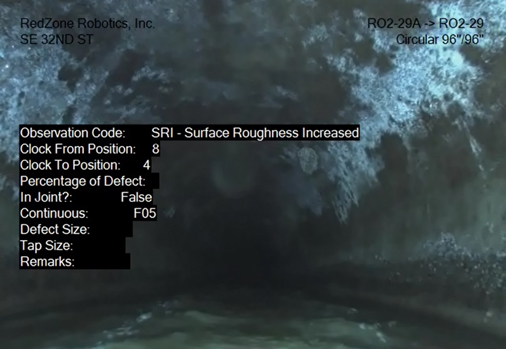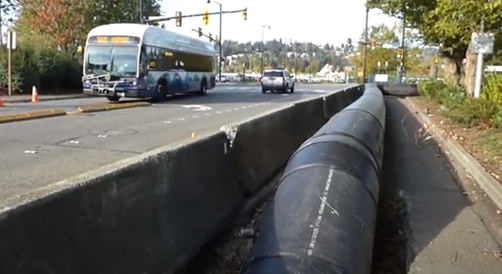About ESI 8
Get information about the ESI 8 Rehabilitation Project schedule, project need, and construction process.
Project need
King County Wastewater Treatment Division protects public health and the environment by collecting and cleaning wastewater and recovers valuable resources for a thriving Puget Sound region. ESI 8 is breaking down due to age and corrosion and needs to be repaired to prevent failure, overflow, or disruption of service. Completing this project will support the reliability of a key part of the regional wastewater treatment system on the Eastside for 50 years to come.

Picture of pipe breakdown/corrosion
Videos
- Condition of the ESI sewer pipes on Closed Circuit Television Video (CCTV)
- LiDAR Survey 1 ESI Section 8: Scan in Upstream Direction – Approximate Distance 188 FT
- LiDAR Survey 2 ESI Section 8: Scan in Upstream Direction – Approximate Distance 2,383 FT
- LiDAR Survey 3 ESI Section 8: Scan in Downstream Direction – Approximate Distance 3,046 FT
Maintaining sewer service during the repair
To repair ESI Section 8, all the sewage it carries (approximately 55 million gallons per day during the dry season) will need to be sent into a temporary system of pumps and pipes above ground. This temporary system will allow crews to work inside the existing pipe while maintaining sewer service to the community.
To limit disruptions to neighbors and commuters, the temporary pipes will follow the King County Eastside Rail Corridor (ERC) and exit from the corridor near the I-405/Coal Creek Parkway intersection. At this location, the temporary sewer diversion pipe will cross I-405 and discharge into a maintenance hole on the east side of I-405. We plan to engage the community before work begins to limit surprises and answer questions

We have an opportunity to implement a different contracting method that other agencies, including other King County Departments, have successfully used before. One key component of this delivery method is the early collaboration on constructability with the contractor.
Project Schedule

-
Pre-design
During the pre-design, we will:
- Approve the project charter
- Explore the preliminary permit planning
- Community service planning and interested parties’ (or stakeholders) analysis
- Contracting KC’s project advisor
-
Design
During the design stage, we will:
- Develop the design and construction schedule.
- Complete design including determining the location of the temporary diversion pipe which will carry wastewater during pipe rehabilitation, and the sewer rehabilitation approach and staging areas
- Acquire permits and local agency coordination
- Implementation of Early Work Packages to expedite construction.
- Identify impacts on the surrounding community and develop appropriate outreach and communication plan
- Launch project webpage
-
Implementation and close out
During the implementation phase, we will:
- Prepare the site for construction
- Install and operate the temporary diversion system
- Rehabilitate the existing M Street Trunk
- Demobilization of the temporary diversion systems once rehabilitation activities are complete
- Restore and clean up from construction
- Provide update to impacted neighbors and the surrounding communities.
- Close out

 Translate
Translate